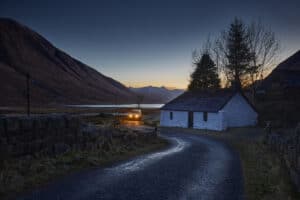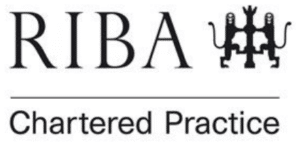Part of my job as an Associate with Thomas Robinson Architects is travelling up and down the bens and glens of Scotland with practice director Tom Robinson, meeting future and current clients. It’s one of my favourite aspects of what I do. It feels a long way from previous positions I’ve held designing exclusive hotels in Edinburgh or taking on fast-paced architectural jobs in London, but I secretly knew I’d end up back home. I’ve always felt connected to rural Scotland.
Driving, flying – and sometimes ferrying – from here in the central belt, where the hills are just beginning, to West coast islands where the smell of heather and peat evokes my childhood spent holidaying on Jura, and to the Highlands where the mountains impose themselves swathed in mist, with views punctuated by a white cottage at the foot, always reconnects me with Scotland in a fundamental way. I have a slightly romantic yearning for a simpler approach to life that’s more about natural surroundings than urban scapes.
My links with Jura go back a long way. My ancestors come from there, and while my family left as permanent residents a few generations ago, we have always kept close ties with the island, and with friends and the community. We are lucky enough to have an old forestry cottage out there, located in the village less than 10 minutes from the pub. Our island days have always been about walking, whisky, peat fires, and food.
I remember a Jura visit with city friends when at university, and after a rainy walk, returning to find that no-one had lit a fire. They hadn’t considered it. While rules brought in by the Scottish government (and seemingly ditched) around having open fires may, to some, be controversial, it seemed astonishing to me that this key part of the day hadn’t happened. For me a fire is an essential part of rural living, and part of a culture I’ve been steeped in all my life.
The rainy walk is an important part of the story, because there’s something about rural Scottish life where you really have to be at one with the weather. It’s part of the landscape; the winds and water have literally shaped it over millennia. Walking home, seeing smoke puffing from the chimney and maybe a glow of yellow light from the window is a magnetic pull, promising warmth and good cheer. (Likewise, sight of a village pub after a long hike, but that’s a blog for another day.) These days I visit Jura with my own kids, and rekindle my own childhood memories of rushing to the beach, although now I look forward to that fireside whisky in the evening with equal zeal.
There’s something about being in rural locations in Scotland that is bonding, too – OK, I’m not naive about the fact that there can be a separation between locals and tourists, but, particularly if you live there – and particularly on the islands, there is a bond forged between people there. You can feel it even on the ferry over. Successful rural life requires a sense of community, whether that’s just from a daily visit to the village shop, pint in the pub, or spending every summer there.
I think this element of rural connection is something that all of us at Thomas Robinson Architects share to some extent. Tom has written about his love of architectural projects on Scottish islands, and while Fiona is skilled at contemporary architecture, her connection with Skye, and with the sea often comes through in her designs, which are a triumph of practical know-how balanced with spaces that just work. And both directors are outdoorsy people. I think if our practice were based in central Edinburgh, it may be filled with slightly different people and have an alternative slant on its approach to buildings and landscape.
A lot of our work is in rural and semi-rural locations, from an impressive estate house on Jura where we worked as executive architects; in fact I was lucky enough to get to work on that Jura project when I first came to Thomas Robinson Architects – it’s a wonderful jewel of a house. My current favourite project is on the isle of Mull. It’s about to go to site and is special for me as it has given me an opportunity to connect with another of Scotland’s islands.
As a practice, we are very familiar with working on former crofting cottages that need a new lease of life. And of course there have been plenty of grand country mansions, too, as well as listed Baronial estate properties, historic castle refurbishments, and newbuild farmhouses built in traditional style.
The beauty of building new (as well as renovating) properties in beautiful Scottish locations is that it gives us the chance to make the best possible houses for these environments. We can prioritise magnificent views (like the seascapes from these holiday houses on the isle of Lewis), and make them energy efficient and warm with modern sustainable systems. One of our first considerations when building anywhere in Scotland is how our designs will work in the local area – what is the architectural vernacular of the area, what are the references, what is around the site. These all inform the design; no-one wants a house that just doesn’t fit in. And we ensure that our materials make sense too, using local stone, timber, and typical finishes in these rural houses.
With several exciting rural projects on our books at the moment, the excitement of landscape for me continues to be nourished. And I always look forward to the next chance to hop in the car and travel to the outer reaches of this beautiful country to some new dazzling spot for a potential new project.
Got a rural Scottish project in mind? Contact us.
























